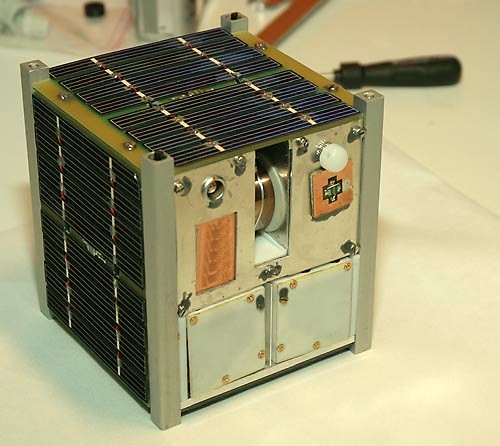|
Ecuadorian Space Agency
The Ecuadorian Civilian Space Agency (EXA; ) is a private Ecuadorian organization founded in 2007 that conducts research on space and planetary sciences. It is a non-profit non-governmental organization with civilian oversight. EXA had tested microgravity via parabolic flight with the Ecuadorian Air Force. EXA launched Ecuador's first satellite, the CubeSat A CubeSat is a class of small satellite with a form factor of cubes. CubeSats have a mass of no more than per unit,, url=https://static1.squarespace.com/static/5418c831e4b0fa4ecac1bacd/t/5f24997b6deea10cc52bb016/1596234122437/CDS+REV14+2020-07-3 ... NEE-01 ''Pegaso'', in April 2013 aboard a Chinese Long March 2D. Its second satellite, the follow-on CubeSat NEE-02 ''Krysaor'', was launched from Russia aboard a Dnepr rocket in November 2013. Notes References External links * (in English) {{authority control Non-profit organisations based in Ecuador Research institutes in Ecuador Space organizations ... [...More Info...] [...Related Items...] OR: [Wikipedia] [Google] [Baidu] |
Guayaquil
Guayaquil (), officially Santiago de Guayaquil, is the largest city in Ecuador and also the nation's economic capital and main port. The city is the capital (political), capital of Guayas Province and the seat of Guayaquil Canton. The city is located on the west bank of the Guayas River, which flows into the Pacific Ocean at the Gulf of Guayaquil. With a population of 2,746,403 inhabitants, it is the most populous city in the country, and the fifth largest in the Andean Community. However, its urban fabric extends beyond its official urban parishes, encompassing nearby cities and parishes; thus, the Guayaquil metropolitan area reaches a population of 3,618,450, making it the most populous urban agglomeration in the nation, and also the fifth in the Andean Community. As the largest city, it is one of the two main development poles of the country—alongside Quito, the national capital—hosting Ecuador’s main business, financial, cultural, and sports institutions. After seve ... [...More Info...] [...Related Items...] OR: [Wikipedia] [Google] [Baidu] |
Non-governmental Organization
A non-governmental organization (NGO) is an independent, typically nonprofit organization that operates outside government control, though it may get a significant percentage of its funding from government or corporate sources. NGOs often focus on humanitarian or social issues but can also include clubs and associations offering services to members. Some NGOs, like the World Economic Forum, may also act as lobby groups for corporations. Unlike international organizations (IOs), which directly interact with sovereign states and governments, NGOs are independent from them. The term as it is used today was first introduced in Article 71 of the UN Charter, Article 71 of the newly formed United Nations Charter in 1945. While there is no fixed or formal definition for what NGOs are, they are generally defined as nonprofit entities that are independent of governmental influence—although they may receive government funding. According to the United Nations Department of Global Communic ... [...More Info...] [...Related Items...] OR: [Wikipedia] [Google] [Baidu] |
Microgravity
Weightlessness is the complete or near-complete absence of the sensation of weight, i.e., zero apparent weight. It is also termed zero g-force, or zero-g (named after the g-force) or, incorrectly, zero gravity. Weight is a measurement of the force on an object at rest in a relatively strong gravitational field (such as on the surface of the Earth). These weight-sensations originate from contact with supporting floors, seats, beds, scales, and the like. A sensation of weight is also produced, even when the gravitational field is zero, when contact forces act upon and overcome a body's inertia by mechanical, non- gravitational forces- such as in a centrifuge, a rotating space station, or within an accelerating vehicle. When the gravitational field is non-uniform, a body in free fall experiences tidal forces and is not stress-free. Near a black hole, such tidal effects can be very strong, leading to ''spaghettification''. In the case of the Earth, the effects are minor, especiall ... [...More Info...] [...Related Items...] OR: [Wikipedia] [Google] [Baidu] |
Ecuadorian Air Force
The Ecuadorian Air Force (; FAE) is the air branch of the Armed Forces of Ecuador. Mission To develop the military air wing, in order to execute institutional objectives which guarantee sovereignty and contribute towards the nation's security and development. Vision To be a dissuasive Air Force, respected and accepted by society, pioneering within the nation's air-space development. History The FAE was officially created on October 27, 1920. However, like in many other countries, military flying activity started before the formal date of birth of the Air Force. The history of Ecuador is marked by many skirmishes with its neighbour Peru. As a direct result of the 1910 Ecuador-Peru crisis the members of decided to expand their sporting activities into aviation as well. Renamed , they started an aviation school. Cosme Rennella Barbatto, an Italian living in Guayaquil, was one of the first members of . In 1912 Barbato was sent to his native Italy for training where he graduated ... [...More Info...] [...Related Items...] OR: [Wikipedia] [Google] [Baidu] |
CubeSat
A CubeSat is a class of small satellite with a form factor of cubes. CubeSats have a mass of no more than per unit,, url=https://static1.squarespace.com/static/5418c831e4b0fa4ecac1bacd/t/5f24997b6deea10cc52bb016/1596234122437/CDS+REV14+2020-07-31+DRAFT.pdf , title=Cubesat Design Specification , publisher=California Polytechnic State University, San Luis Obispo, Cal Poly SLO , year=2020 , location=San Luis Obispo , pages=12 and often use commercial off-the-shelf (COTS) components for their electronics and structure. CubeSats are deployed into orbit from the International Space Station, or launched as secondary payloads on a launch vehicle. , more than 2,300 CubeSats have been launched. In 1999, California Polytechnic State University (Cal Poly) professor Jordi Puig-Suari and Bob Twiggs, a professor at Stanford University Space Systems Development Laboratory, developed the CubeSat specifications to promote and develop the skills necessary for the design, manufacture, and testing of ... [...More Info...] [...Related Items...] OR: [Wikipedia] [Google] [Baidu] |
NEE-01 Pegaso
NEE-01 ''Pegaso'' (, "Pegasus") is an Ecuadorian technology demonstration satellite, and Ecuador's first satellite launched to space. Built by the Ecuadorian Civilian Space Agency (EXA), it is a nanosatellite of the single-unit CubeSat class. The spacecraft's instruments include a dual visible and infrared camera which allows the spacecraft to take pictures and transmit live video from space. Construction and launch After the completion of its HERMES-A ground station in April 2010, EXA authorised the construction of Ecuador's first satellite. A number of restrictions and demands were imposed on the project: EXA was solely responsible for the spacecraft design and technology research, all construction had to take place within Ecuador, the project must be "future-enabling" and result in a technological breakthrough, and its mission must be educational in nature. The completed ''Pegaso'' was presented to the public on 4 April 2011. All research and construction of the satellite w ... [...More Info...] [...Related Items...] OR: [Wikipedia] [Google] [Baidu] |
Long March 2D
The Long March 2D (), also known as the Chang Zheng 2D, CZ-2D, and LM-2D, is a Chinese two-stage orbital carrier rocket mainly used for launching LEO and SSO satellites. It is manufactured by the Shanghai Academy of Spaceflight Technology (SAST). It is mainly launched from areas LA-2B and LA-4 at the Jiuquan Satellite Launch Center. The Long March 2D made its maiden flight on 9 August 1992. It was initially used to launch FSW-2 and FSW-3 reconnaissance satellites. More recently it has also launched from LA-9 TSLC and LA-3 XSLC. Unlike all other members of the Long March 2 Long March 2 rocket family or Chang Zheng 2 rocket family as in Chinese pinyin is an expendable launch system operated by the People's Republic of China. The rockets use the abbreviations LM-2 family for export, and CZ-2 family within Chi ... rocket family, the Long March 2D is a two-stage version of the Long March 4 launch vehicle. Launch statistics List of launches The Long March ... [...More Info...] [...Related Items...] OR: [Wikipedia] [Google] [Baidu] |
NEE-02 Krysaor
NEE-02 ''Krysaor'' is an Ecuadorian technology demonstration satellite, and Ecuador's second satellite launched to space. Built by the Ecuadorian Civilian Space Agency (EXA), it is a single-unit CubeSat nanosatellite A small satellite, miniaturized satellite, or smallsat is a satellite of low mass and size, usually under . While all such satellites can be referred to as "small", different classifications are used to categorize them based on mass. Satellites c .... ''Krysaor'' is a Pegasus-class spacecraft, a "twin" of Ecuador's first satellite, NEE-01 ''Pegaso''. Like ''Pegaso'', this spacecraft's instruments include a dual visible and infrared camera which allows the spacecraft to take pictures and transmit live video from space. See also * List of CubeSats References External links ''Krysaor'' official website CubeSats Science and technology in Ecuador Spacecraft launched in 2013 2013 in Ecuador Spacecraft launched by Dnepr rockets {{spacecraft- ... [...More Info...] [...Related Items...] OR: [Wikipedia] [Google] [Baidu] |
Dnepr (rocket)
The Dnepr rocket (; ) was a space launch vehicle named after the Dnieper River. It was a converted ICBM used for launching artificial satellites into orbit, operated by launch service provider ISC Kosmotras. The first launch, on April 21, 1999, successfully placed UoSAT-12, a 350 kg demonstration mini-satellite, into a 650 km circular Low Earth orbit. History The Dnepr was based on the R-36MUTTH Intercontinental ballistic missile (ICBM)called the ''SS-18 Satan'' by NATOdesigned in the 1970s by the Yuzhnoe Design Bureau in Dnepropetrovsk, Ukrainian SSR. among the outstanding authors of the project there are people like Boris Gubanov, Sergey Sopov. The Dnepr control system was developed and produced by the JSC "Khartron", Kharkiv. The Dnepr was a three-stage rocket using storable hypergolic liquid propellants. The launch vehicles used for satellite launches have been withdrawn from ballistic missile service with the Russian Strategic Rocket Forces and store ... [...More Info...] [...Related Items...] OR: [Wikipedia] [Google] [Baidu] |
Wired UK
''Wired UK'' is a bimonthly magazine that reports on the effects of science and technology. It covers a broad range of topics including design, architecture, culture, the economy, politics and philosophy. Owned by Condé Nast Publications, it is published in London and is an offshoot of the original American ''Wired''. History Earlier version (mid–1990s) The magazine's current incarnation follows an earlier attempt at a British edition of ''Wired'' which ran from April 1995 until March 1997. It was initially created as a joint venture with the Guardian Media Group and ''Wired US''s then owners, Wired Ventures, but that incarnation lasted only three or four issues, due to a culture clash between the two parties and low sales figures of 25,000 per month. Wired Ventures then ran the UK edition alone, with an almost entirely new staff, until the magazine was closed with the March 1997 issue, when sales were at 40,000 magazines per month. Current version (2009–present) Th ... [...More Info...] [...Related Items...] OR: [Wikipedia] [Google] [Baidu] |
Non-profit Organisations Based In Ecuador
A nonprofit organization (NPO), also known as a nonbusiness entity, nonprofit institution, not-for-profit organization, or simply a nonprofit, is a non-governmental (private) legal entity organized and operated for a collective, public, or social benefit, as opposed to an entity that operates as a business aiming to generate a profit for its owners. A nonprofit organization is subject to the non-distribution constraint: any revenues that exceed expenses must be committed to the organization's purpose, not taken by private parties. Depending on the local laws, charities are regularly organized as non-profits. A host of organizations may be non-profit, including some political organizations, schools, hospitals, business associations, churches, foundations, social clubs, and consumer cooperatives. Nonprofit entities may seek approval from governments to be tax-exempt, and some may also qualify to receive tax-deductible contributions, but an entity may incorporate as a nonprofit en ... [...More Info...] [...Related Items...] OR: [Wikipedia] [Google] [Baidu] |




